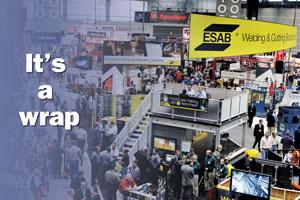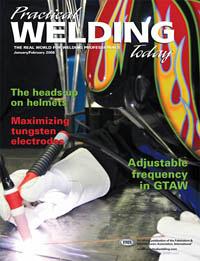- FMA
- The Fabricator
- FABTECH
- Canadian Metalworking
Categories
- Additive Manufacturing
- Aluminum Welding
- Arc Welding
- Assembly and Joining
- Automation and Robotics
- Bending and Forming
- Consumables
- Cutting and Weld Prep
- Electric Vehicles
- En Español
- Finishing
- Hydroforming
- Laser Cutting
- Laser Welding
- Machining
- Manufacturing Software
- Materials Handling
- Metals/Materials
- Oxyfuel Cutting
- Plasma Cutting
- Power Tools
- Punching and Other Holemaking
- Roll Forming
- Safety
- Sawing
- Shearing
- Shop Management
- Testing and Measuring
- Tube and Pipe Fabrication
- Tube and Pipe Production
- Waterjet Cutting
Industry Directory
Webcasts
Podcasts
FAB 40
Advertise
Subscribe
Account Login
Search
It's a wrap
Recapping the 2007 FABTECH International & AWS Welding Show
- By Amanda Carlson
- January 15, 2008
- Article
- Shop Management
It's no surprise that show organizers, attendees, and exhibitors alike are billing the 2007 FABTECH® International & AWS Welding Show as one of the best ever. If you were there, then you know why. If not, the numbers tell the story, albeit not the whole story.
According to show organizers, 31,354 people from more than 75 countries turned out for this year's event, held at Chicago's McCormick Place and cosponsored by the Fabricators & Manufacturers Association (FMA) Intl., American Welding Society (AWS), and the Society of Manufacturing Engineers (SME). This number is a 29 percent increase compared to the 2005 show in Chicago. Exhibitors, all 1,094 of them, took up 461,825 sq. feet of booth space in the North and South Halls. The welding industry was well-represented, accounting for 145,750 sq. feet of exhibitor space.
The theme throughout the show no doubt was helping fabricating and welding shops face the shortage of skilled labor head-on with automation. As the shortage continues to expand its reach into both large and small companies, welding shops are turning to automation to help fill in the gaps and remain competitive. Suppliers have answered that call by offering equipment and products that are increasingly flexible and user-friendly, targeting a work force that is declining in volume and experience.
Skilled-Worker Shortage: A Panel Discussion
Covering what's top of mind for many, the show hosted a Leadership Summit panel on the skilled-labor shortage. Panelist David Hanson, a Chicago commissioner for the Mayor's Office of Workforce Development, spoke of regional efforts to support manufacturing, and Anthony Swoope, administrator, Office of Apprenticeship, Employment and Training Administration for the Labor Department, gave a national scope. Swoope's office registers apprenticeship programs across the country and is responsible for giving states some $16 billion annually to aid work force development—carrying out the mission of the National Apprenticeship Act, which was signed 70 years ago.
"I started out as a sheet metal apprentice," said Swoope, "and I remember the talent I needed to develop using heliarc [GTAW] to weld aluminum. I found very quickly that it's an art to be able to get the right heat, the right flow. And with that art comes a lot of skill [built upon] math and science."
Panelist Jim Reeb, director, manufacturing R&D for Caterpillar, asked the audience some hard-hitting questions. "So how many of you want your children to grow up to be welders?" A fraction of the audience members raised their hand. "OK, now how many of you want your children to go on to a four-year college?" A sizable number of hands went up in response.
He made his point.
Drawing from the panelists' comments, we might group the skilled-labor problem into two areas. One, current manufacturing job recruiters have been scraping the bottom of the barrel, with too many unfocused, unmotivated workers ending up on the factory floor. Two, the skilled-labor problem soon won't be just about the lack of skilled workers, but about the lack of workers—period. Said Reeb, "In the near future we will lose about 76 million baby boomers, and we only have about 46 million Gen Xers behind them. Now that's a labor shortage. Soon we will outsource not because of cheap labor; it's because we'll want any labor."
The problem seems so daunting, especially at a time of record production. Many have said the future U.S. manufacturing worker will need to produce a tremendous amount of goods thanks to automation and innovative thinking. This represents a new breed of manufacturers, those having the skill of a trained journeyman together with an entrepreneur's creativity. And here's the rub: Not just any Joe Schmo can do these jobs.
Fellow panelist Dan Swinney said his organization has made an attempt to help. His Chicago Manufacturing Renaissance Council spearheaded a project with the help of local government programs and industry associations to launch what many in metal fabrication have yearned for: a school that focuses on educating this new breed of manufacturer.
The Products
Hybrid welding pairs two technologies to work in tandem to achieve a synergistic effect, allowing both processes to benefit from the strengths of its partner.
The Super-MIG™ system from Welding Solutions Inc., a provider of fully integrated welding systems, combines plasma and gas metal arc welding (GMAW) to achieve increased welding speeds under variable gap conditions, deeper weld penetration, improved aesthetic, and a narrower heat-affected zone (HAZ).
"Plasma is slow but it's reliable and clean. GMAW is fast but is, at times, unreliable," said Ray Davis, sales and marketing manager for Welding Solutions. The two processes together allow for both speed and reliability.
The interface and torch are patented by Plasma Laser Technologies and are designed for use with Lincoln, Miller, Panasonic, OTC-Daihen, and ESAB GMAW systems.
The hybrid system can weld standard industrial-grade steels, stainless steel, high-strength coated metals, and titanium.
ESAB Welding & Cutting Products has partnered with TRUMPF Inc. to introduce the HLx series, which pairs GMAW with TRUMPF's TruDisk laser resonator.
Hybrid laser-arc welding (HLAW) combines the deep weld penetration and low heat input associated with laser welding with the power efficiency and gap tolerance of GMAW. Laser's deep penetration can limit its ability to produce acceptable weld fusion in weldments with wide gaps between parts. Adding GMAW, as well as a modest amount of filler metal, creates a wider weld bead capable of bridging larger weld gaps.
The system's closed-loop control allows it to monitor the weld joint in real time and modifies the process to accommodate a joint mismatch. It is available as a robotic system, a portable tractor system, or on a moving gantry.
SmartTCP has developed an automatic welding system for complex, low-batch part production. Hardware and software are combined in a flexible welding cell that automates both the robot programming and the weld processes.
The system comprises a robot system, external axis motors, control technologies, and positioners supplied by KUKA Robotics; a welding power source provided by Fronius; a gantry system from Gdel, and software by SmartTCP. The basic system is constructed of nine axes (six-axis robot and three-axis gantry) with additional manipulators of one or two axes as needed, up to 16 axes.
The torch is always in position, said Efi Lebel, CEO of SmartTCP, and the system is flexible enough to accommodate small or large products.
United Air Specialists introduced the SDB downdraft bench dust collector designed for applications in which workers need an integrated collection area and work surface. With a downdraft velocity of up to 100 FPM and air volumes up to 2,500 CFM, the unit captures smoke, dust, and powders resulting from a variety of manufacturing operations, including grinding, polishing, hand sanding, and dry buffing.
The unit helps companies comply with OSHA regulations by drawing particles and contaminants away from the worker's breathing zone. Removing the pollutant particles close to the source also prevents dust from migrating to areas with sensitive electrical and mechanical equipment, reducing facility maintenance.
The unit's 80- by 55-in. grated work surface can accommodate loads of up to 75 lbs. per sq. foot. Hinged side wings open to accommodate large workpieces.
Bug-O Systems offers the All Time Girth Welder, a self-propelled welding system for horizontal welding in field storage tank fabrication. The company says field storage tank welding time is reduced up to 40 percent with the uint, and weld defects also are reduced.
The submerged arc welding (SAW) system has a Lincoln Electric NA-3 control and welding head fitted with wire feed rolls, nozzles, straighteners, and 50-lb. wire reels. The machine is equipped with a flux recovery system for the recycling of flux. An adjustable frame accommodates plate from 6 to 10 ft. long.
Lincoln Electric has expanded its Invertec® welding line with the addition of the V205-T DC and upgraded its V205-T AC/DC.
The V205-T AC/DC is a compact GTAW power source intended for critical AC or DC welding. Updates included added circuitry in the stick crisp mode for 6010 electrode welding performance, improved GTAW arc starting, and selectable start polarity. It also includes adjustable GTAW strike current, widened AC GTAW start power range for minimizing tungsten erosion, redesigned power electronics for improved reliability, and a voltage reduction device (VRD).
The unit offers selectable waves shapes to tailor the arc performance specific to the welding application. Operators can choose a square-wave shape for fast travel speeds and excellent puddle control; a sine wave for a soft-sounding arc; or a triangular wave at low amperages to reduce the heat input into the weld.
The Invertec V205-T DC has the same added features as the V205-T AC/DC minus the AC GTAW. It offers 200 amps at 40 percent duty cycle and reconnects for single-phase, 115/230-V, 50/60-Hz input.
ABB Robotics introduced the IRB 1600ID robot with integrated dressing, which routes all cables and hoses inside the upper arm, making it suitable for arc welding applications. The robot features a dress pack that carries all necessary media for arc welding, including power, welding wire, shielding gas, and pressurized air.
The company said concealing the dress pack inside the robot's upper arm eliminates common external routing problems, such as a swinging dress pack while the robot is in motion. The integrated dressing helps to decrease the robot's external dimensions, extending the robot's real working range—an important factor when welding on fixtures with complex geometry. It also helps to eliminate the risk of damaging the dress pack in a collision.
About the Author

Amanda Carlson
2135 Point Blvd
Elgin, IL 60123
815-227-8260
Amanda Carlson was named as the editor for The WELDER in January 2017. She is responsible for coordinating and writing or editing all of the magazine’s editorial content. Before joining The WELDER, Amanda was a news editor for two years, coordinating and editing all product and industry news items for several publications and thefabricator.com.
About the Publication
Related Companies
subscribe now

The Welder, formerly known as Practical Welding Today, is a showcase of the real people who make the products we use and work with every day. This magazine has served the welding community in North America well for more than 20 years.
start your free subscription- Stay connected from anywhere

Easily access valuable industry resources now with full access to the digital edition of The Fabricator.

Easily access valuable industry resources now with full access to the digital edition of The Welder.

Easily access valuable industry resources now with full access to the digital edition of The Tube and Pipe Journal.
- Podcasting
- Podcast:
- The Fabricator Podcast
- Published:
- 04/16/2024
- Running Time:
- 63:29
In this episode of The Fabricator Podcast, Caleb Chamberlain, co-founder and CEO of OSH Cut, discusses his company’s...
- Industry Events
16th Annual Safety Conference
- April 30 - May 1, 2024
- Elgin,
Pipe and Tube Conference
- May 21 - 22, 2024
- Omaha, NE
World-Class Roll Forming Workshop
- June 5 - 6, 2024
- Louisville, KY
Advanced Laser Application Workshop
- June 25 - 27, 2024
- Novi, MI

































